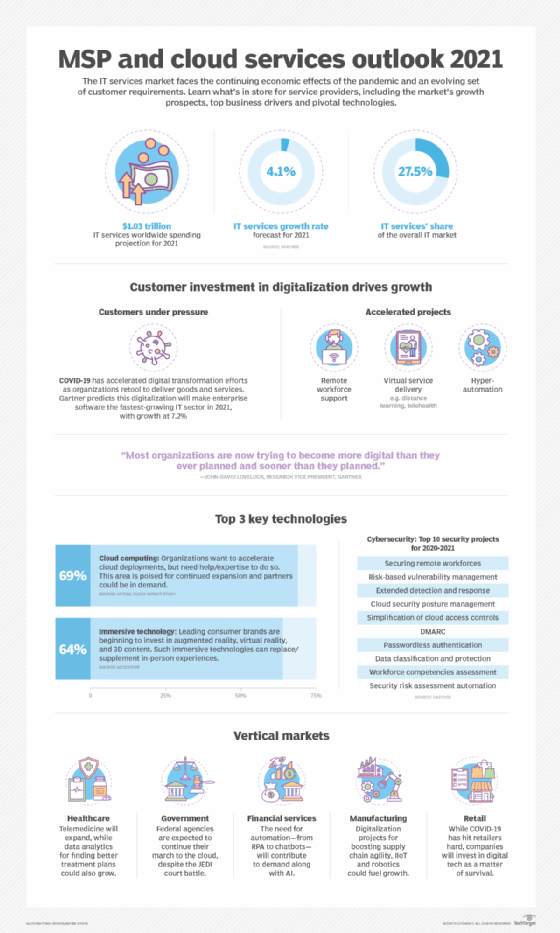
tbralnina - stock.adobe.com
Vertical marketing strategies shouldn't dismiss QSR, retail
The pandemic has pummeled restaurants and retailers, but service providers could still find opportunities in areas ranging from contactless technology to virtual reality.
Food services and retail rank among the industries COVID-19 has hit hardest; yet, some channel partners include those beleaguered sectors in their vertical marketing strategies.
The pandemic has compelled many restaurants and brick-and-mortar stores to reinvent product and service delivery, with technology emerging as a key enabler. IT service providers expect to see such businesses boost their adoption of digital commerce, contactless technology and data analytics in 2021.
"A lot of the industries most massively being impacted are looking to technology to solve their problems," said Shawn Mills, CEO at Lunavi, an MSP and technology consultancy based in Cheyenne, Wyo.
He cited retailers and restaurants as heavily disrupted businesses that hope to persevere through technical innovation.
"They have to adopt new technologies," Mills said. "It's not a luxury for those industries -- it's a life or death kind of reality."
Restaurants turn to tech
Mills said he recently heard from a food services company looking to change its business model to cope with the pandemic.
"The way they push out the technology to do that is critical to their success [in the] long term," he said.
 Shawn Mills
Shawn Mills
The quick-service restaurant (QSR) segment of the food services industry is particularly inclined to take on new technology. QSRs characteristically serve up fast food and offer limited seating. They are often more digitally advanced than table-service restaurants, which traditionally emphasized dine-in amenities.
COVID-19, however, has made contactless experiences the new normal, said Chris Murphy, CEO at ThoughtWorks, a software consultancy based in Chicago. The goal is an end-to-end digital operation that encompasses ordering, payment and support, as well as in-store interaction or delivery.
"The expectation is … experiences in-store [or] with an app can be done with limited physical contact," he said.
Customers want to use their own device to order from a menu, rather than an in-store tablet, and prefer to pay using their phone or wearables, rather than an in-store payment device, Murphy said.
To meet those demands, QSRs must invest in contactless payment hardware and software, he said. They also need to develop the underlying technology platforms, responsive websites and mobile applications that let customers order, pay and interact digitally with the QSR.
 Chris Murphy
Chris Murphy
Most QSRs will tackle those objectives using a combination of third-party systems or services and their own in-house technology capabilities, Murphy said. Accordingly, channel partners that specialize in the quick-service segment may find their efforts rewarded.
QSRs will "engage third-party service providers to bring in the necessary expertise to build and transform key platforms and systems," Murphy said.
Partners will find the majority of QSRs have already invested in contactless infrastructure and the basics of digital operations. In 2021, those restaurants will look to upgrade to address any gaps in contactless business processes and technologies. Many QSRs have fallen short when it comes to providing a cohesive contactless experience that rivals or exceeds what customers have come to expect from online retailers, Murphy said.
The challenges for QSRs, he noted, include making sure loyalty programs are readily available through their contactless channels and website and mobile app integration with payment options such as Apple Pay, Google Pay, PayPal and Venmo.
 Tony Safoian
Tony Safoian
Retailers to up their digital game
Non-restaurant retailers could also emerge as an important segment for partners' vertical marketing strategies. Tony Safoian, president and CEO at SADA Systems, a technology and business consulting firm based in Los Angeles, views the market as highly bifurcated: Traditional retailers that failed to digitalize product and service delivery have suffered during the pandemic, while those with a mature online presence -- such as The Home Depot and Best Buy -- have fared far better.
The digital laggards will need to accelerate their adoption of e-commerce platforms as a basic, foundational step, Safoian said. The cloud, he suggested, can facilitate this technology direction, noting the Shopify e-commerce runs on Google Cloud Platform (GCP). SADA is a Google Cloud partner.
Retailers that previously deployed e-commerce platforms can build upon their investments, making better use of the consumer data the platforms regularly collect. Understanding buyer preferences and shopping patterns can turn one-time purchasers into engaged fans of a brand, Safoian said.

Partners can take the opportunity to help retailers sharpen their customer insights with data and analytics. Safoian said Google's BigQuery data warehouse, coupled with and GCP's analytics and machine learning services, help stores fine-tune inventory ordering and predict customer behavior.
"Retail customers are adopting these technologies and we expect the trend to continue and gain momentum in 2021," Safoian said. "In our view, these are must-have components for any digitally transformed retailer or consumer products company."
 Rori DuBoff
Rori DuBoff
Partners can also expect the more digitally adept retailers to offer customers virtual experiences using virtual reality (VR), augmented reality (AR), 3D content and 360-degree video. The shift has already begun, according to Accenture, which, in September 2020, published a study on VR and AR, 3D content and 360-degree video and their use among leading consumer brands. Rori DuBoff, managing director of strategy and innovation at Accenture Interactive, said retailer acceptance of those immersive technologies is happening faster than she expected.
"Surprisingly, we found 64% of brands have already invested in some sort of immersive experience on a website or mobile app," she said. The Accenture study cited retailers uploading 3D models to product pages as an example applying immersive technology to online shopping. The pandemic has accelerated retailer interest in the virtual approach, DuBoff noted.
Revising contactless systems
Some retailers will revisit the contactless systems they deployed early on in the coronavirus pandemic.
 Pawan Gupta
Pawan Gupta
Pawan Gupta, commerce and omnichannel services principal at Perficient, a digital transformation consulting firm based in St. Louis, said he believes retailers that hurriedly put systems in place will look to improve upon them in 2021. For example, many retailers launched curbside services during 2020, letting customers order online and pick up their purchases outside of the store. Retailers, however, often had to improvise, "duct taping technologies and processes" to quickly meet customer demand, he said.
"Going into 2021, they want to take a more holistic approach and see how they can make those [ordering and pickup] experiences even better," Gupta said.
To wit, retailers can deploy technologies such as geofencing to bolster their curbside pickup programs. Geofencing uses GPS and RFID to create a perimeter around a particular area -- a store parking lot, in the case of retail. Geofencing alerts stores when a customer who has downloaded the retailer's mobile app and enabled location services enters the lot. Geofencing triggers a retailer's order fulfillment system to send an SMS notification to a store associate's mobile device. That way, the associate knows when customers arrive and where they are parked in the lot. "This capability can transform the entire store's parking lot into serviceable space," Gupta said.
The pandemic, which caused retailers to accelerate digital transformation this year, will continue to spark industry innovation in the coming months, he noted.
"Retailers have learned a lot during this disruption," Gupta said. "There will be a lot more evolution in 2021."
Forecasting, planning tools on the horizon
The pandemic compelled retailers to adopt new order-fulfilment methods, including ship from store and curbside pickup.
Individual outlets began to operate as mini distribution centers, packing and shipping products to customers instead of offering traditional in-store shopping. Curbside services, meanwhile, have store associates in the stock room packaging orders for delivery.
In this new environment, managing inventory has emerged as a big problem for retailers, Perficient's Gupta said. Which stores should carry what type of inventory and how much?
To address such questions, Perficient's retail customers will be implementing forecasting and planning tools in 2021, Gupta predicted. In-store inventory planning and logistics systems from vendors such as Adobe, IBM and Manhattan Associates are among the available options, he said.
Retailers are gravitating to vendors' cloud-based forecasting and planning offerings, which eliminate infrastructure management and provide scalability to handle seasonal spikes in order volume.








